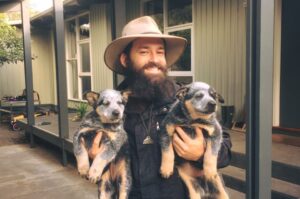In research published in the journal Science, researchers observing sulphur-crested cockatoos have proven that they teach each other new skills. In this instance, it is opening garbage bin lids to scavenge for food.
The study was led by Dr Barbara Klump and Dr Lucy Aplin of the Germany-based Max Planck Institute of Animal Behavior, in partnership with Dr John Martin of the Taronga Conservation Society and Dr Richard Major from the Australian Museum.
“Demonstrating that food scavenging behaviour is not due to genetics is a challenge,” said Dr Klump.
“Children are masters of social learning. From an early age, they copy skills from other children and adults. However, compared to humans, there are few known examples of animals learning from each other.”
Dr Major is the senior principal research scientist at the Australian Museum’s Research Institute. He has been studying Australian birds for more than for 40 years. That has included cockatoos as well as the “bin chicken” Ibis and the noisy miner.
This particular study of cockatoo social behaviour arose several years ago. Dr Major shared a video of a cockatoo cleverly opening a garbage bin with Dr Aplin, then a researcher at Oxford University in the UK, and Dr Klump. It piqued the interest of his fellow scientists.
“It was so exciting to observe such an ingenious and innovative way to access a food resource, we knew immediately that we had to systematically study this unique foraging behaviour,” said Dr Klump.
Cockatoos bin-diving across greater Sydney
In 2018, the researchers launched a survey in Australia to compile examples of the bin-raiding behaviour.
“The survey ran for two years and helped us determine how the behaviour spread to other cockatoos in Sydney,” Dr Martin said.
By the end of 2019, residents from 44 areas reported observing cockatoos opening bin lids. This, noted the researchers, demonstrates the behaviour was not isolated to a single area or flock.
Analysis of the data showed the behaviour spread more rapidly in adjoining areas than areas further afield. This discovery eliminated the prospect of it being random or genetic.
Concurrently with the survey, the team marked around 500 cockatoos with small paint dots in three “hot spot” locations. The aim was to observe how many of the birds could open the bins.
They found that only around 10 per cent could do so, and the majority were males. The rest waited for ‘pioneer’ cockatoos to work their magic and then join the garbage feast.
Another discovery was that cockatoos don’t have a single technique for opening the lids.
“We observed that the birds do not open the garbage bins in the same way, but rather used different opening techniques in different suburbs, suggesting that the behaviour is learned by observing others,” Dr Klump said.
‘Little buggers’
Numerous people responded to a 2018 post about the survey on the Australian Museum’s Facebook page with their own observations of cockatoos in action.
“Come to Helensburgh on bin night, little buggers work in teams, and send scouts out looking for bins that they can raid. People are cabling tying bottles of water to the lids to keep them from being able to lift them,” said Rod Herbert.
Another commenter, Janelle Reynolds de Soza, said: “They are certainly the new bin chickens in Gymea Bay! Recently I saw one perched on a bin, while having a good old gnaw on a chicken drumstick. That makes them ‘Bin Chicken Cannibals’.”
Meanwhile Leasa De Klerk commented: “I haven’t just seen them open bins, I’ve seen them work in pairs where one holds the bin open while the other one raids it. I used to sit and watch them after work.”
Observations ongoing
Sulphur-crested cockatoos are common across Australia’s eastern seaboard. Anecdotally at least, the behaviour of bin-scavenging is not isolated to greater Sydney.
For instance, a video posted to YouTube on 2 May 2020 shows cockatoos opening a beach-side bin at Lorne in Victoria.
“I and my girlfriend were on the Great Ocean Road in Australia. I decided to take a break from driving and parked in front of a beach in Lorne, Victoria. We noticed this one bird and one bird only could open the bin lid while all the others patiently waited for him to open it, YouTube poster ViralHog said in a note attached to the video.
“The locals acted like it was a common thing for the birds to make a mess, so many people would close the bin, but that one bird just kept coming back.”
The researchers are keen for more people to report their sightings of cockatoos opening bin lids. That includes from outside the Sydney area.
“Cockatoos are in-your-face winners with attitude – full of life, humour, and mischief, but always showing keen intelligence, natural curiosity and proven adaptability,” said Dr Major.
“Through this research and other projects, we are building a comprehensive picture of our native wildlife so that we can continue to share our neighbourhoods and have our lives enriched by the wonder of birds.”
The survey is continuing in Spring 2021. Anyone observing similar cockatoo behaviour can report it by participating in the Big City Birds survey.










